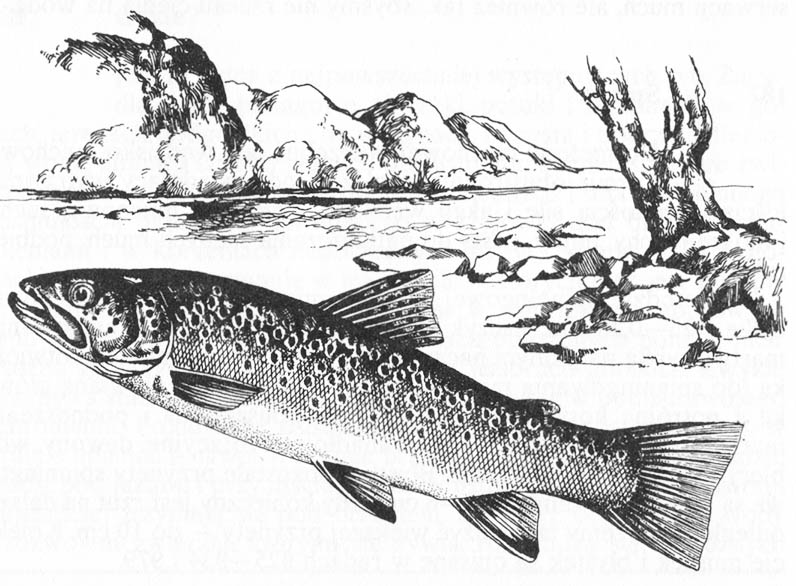PSTRĄG TĘCZOWY
Gdzie?
Wymagania środowiskowe pstrąga tęczowego są bardzo zbliżone do wymagań pstrąga potokowego. Występuje w dolnych odcinkach wód pstrągowych, w tych miejscach krainy lipienia, które w zimie nie zamarzają, i gdzie temperatura wody nie spada poniżej 2—3 °C. Dobre warunki znajduje w wielu zbiornikach zaporowych. Mimo że nie są mu niezbędne kryjówki, najchętniej przebywa w miejscach o urozmaiconym dnie i brzegach. Zasięg jego występowania jest ograniczony. Wielokrotnie stwierdzano, że po zarybieniu wody tęczakiem ryby te szybko z niej wywędrowywują.
Inne uwagi.
Metody połowu, przynęty oraz sprzęt są takie same, jak na pstrąga potokowego. Na muchę bierze jeszcze jesienią nawet po silniejszym ochłodzeniu. Może osiągać dużą masę i rozmiary, toteż w tych wodach, w których występują takie okazy, stosujemy cięższy i mocniejszy sprzęt. Jest wielkim drapieżnikiem, żarłocznym i bojowym. Przywieziony został z Północnej Ameryki w końcu ubiegłego wieku. Zadomowił się tylko w niektórych ciekach. Powszechnie produkuje się go w obiektach stawowych typu pstrągowego, a także w zimniejszych stawach karpiowych jako rybę dodatkową.
W Polsce czyniono próby zarybiania pstrągiem tęczowym niektórych jezior, zabiegi te jednak nie przyniosły spodziewanych efektów, gdyż ryba ta szybko zanikła. W naszym kraju rzadko spotyka się go w wodach naturalnych; jego wymiar ochronny wynosi 30 cm, a okres ochronny trwa od 1 marca do 31 maja. Dla jego odłowu ustalono limit 5 szt. dziennie, łącznie z innymi pstrągami i lipieniem.

PSTRĄG POTOKOWY (POTOKOWIEC)
Gdzie?
Jest to jedna z najpowszechniej występujących ryb. Zasiedla wody pstrągowe, tj. rzeki, potoki i strumienie w górach, terenach podgórskich i na wyżynach, z czystą i dobrze natlenioną wodą, zimną i szybko płynącą po twardym, kamienistym lub żwirowatym dnie. Wymaga brzegów urozmaiconych i dna zacienionego roślinnością brzegową, obfitującego w kryjówki pod brzegami, kamieniami i w korzeniach nadbrzeżnych drzew i krzewów. W potokach na nizinach występuje w miejscach, w których ciek jest zasilany źródłami artezyjskimi. Dobrze się czuje w zbiornikach zaporowych typu górskiego (pstrągowego) i w ciekach położonych poniżej nich. Można go także spotkać w naturalnych jeziorach górskich. Zwykle przebywa stale na tym samym stanowisku, zawsze w pobliżu swojego schronienia. Pojedyncze osobniki można spotkać znacznie niżej, w krainie lipienia, a nawet w krainie brzany, w ciekach o silnym prądzie wody, pod jazami i przy ujściu potoków pstrągowych. Wiosną pstrągi najczęściej trzymają się pod brzegami, a wraz z ociepleniem wody i rozwojem zwierząt, którymi się żywią, rozchodzą się do różnych miejsc potoku na całej jego powierzchni, aby w określonym czasie ściągać do kryjówek.
Kiedy?
Bierze od kwietnia do końca sierpnia, a zatem przez cały okres, kiedy połowy są dozwolone. W kwietniu, maju i czerwcu przez cały dzień, w lipcu i sierpniu rano i pod wieczór. Czynnikami sprzyjającymi udanym połowom są: pochmurna pogoda lub zmienne zachmurzenie i duchota, słaby wiatr i ciepłe mżawki lub deszcze. Niekorzystne są dni słoneczne, gorące i bezchmurne, ranne i wieczorne mgły z silną rosą lub okresy przed burzą. Pstrągi są kapryśne i wykazują różne zainteresowanie pokarmem (różnymi jego składnikami) i podsuwanymi im przez wędkarzy przynętami. Musimy się stale z tym liczyć i być przygotowani na częste próbowanie różnych rodzajów much i przynęt używanych przy spinningowaniu. Kto dobrze opanował obie techniki połowu pstrągów, najmniej odczuwa letnie „grymasy” tych ryb. W ciągu dnia musimy tak wybrać swoje stanowisko połowowe, aby słońce nas nie oślepiało i nie utrudniało obserwacji much, ale również tak, abyśmy nie rzucali cienia na wodę.
Sprzęt.
Do metody muchowej potrzebne jest wędzisko muchowe i sznur obustronnie koniczny, odpowiadający wytrzymałością i grubością sile i akcji wędziska, przypony muchowe, suche i mokre muchy, nimfy, pasty do natłuszczania suchych much, podbierak.
W metodzie spinningowej musimy mieć wędzisko spinningowe, żyłkę 0,25—0,30 mm, haczyk Perfekt nr 1—2/0 (do spinningowania martwą rybką na jednym haczyku), systemik z trójramienną kotwiczką (do spinningowania martwą rybką na systemiku), ołowianą główkę z potrójną kotwiczką (nr 9 — 11) do opuszczania i podnoszenia martwej rybki, mniejsze błystki wahadłowe i rotacyjne, dewony, woblery i streamery oraz rapale. Błystki i pozostałe przynęty spinningowe są mniejsze, o długości 3—6 cm. Gdy konieczny jest rzut na dalszą odległość, możemy także użyć większej przynęty — do 10 cm.
Metody połowu.
Pstrąga potokowego łowimy metodą muchową na mokre i suche muchy, nimfy, „na trzepaczkę“, na suchą muchę przy brzegu, na przepływankę na mokrą muchę lub nimfę — ze spławikiem. Można też spinningować martwą rybką lub filetem przy zastosowaniu pojedynczego haczyka, martwą rybką na systemiku z jedną trójramienną kotwiczką, martwą rybką lub filetem z zastosowaniem główki ołowianej (kapelusika), a dodatkowo podnosić i opuszczać przynętę, spinningować błystką lub inną ciągniętą sztuczną przynętą, spinningować streamerami.
Inne uwagi.
Pstrąg jest rybą bardzo płochliwą i ostrożną, a przy tym bardzo drapieżną; dlatego nad wodami pstrągowymi należy zachowywać spokój i starać się pozostać nie zauważonym przez rybę. Właściwie nie można przewidzieć, czy pstrągi będą brać. Czasem biorą na muchy, niekiedy na przynęty spinningowe, jeszcze kiedy indziej skuteczne są obie metody połowu. Są dni całkowicie „puste” — bez brań. Kto chce wędkować w każdych warunkach, musi być tak przygotowany i wyposażony, aby w ciągu dnia mógł zastosować każdą dozwoloną przepisami metodę połowu, aktualnie najlepiej odpowiadającą nastrojowi i apetytowi pstrąga.
W jeziorach polskiego Pomorza (zwłaszcza w jeziorze Wdzydze) i w niektórych jeziorach alpejskich żyje troć jeziorowa — forma bardzo bliska pstrągowi potokowemu. W Bałtyku żyje troć, która wchodzi na tarło do rzek; w latach trzydziestych ciągnęła ona jeszcze do Dunajca, Popradu, Jaworzyńskiej Bielki. Osiąga ona znacznie większe rozmiary niż nasz pstrąg potokowy. W niektórych zbiornikach zaporowych, do których dopływają potoki o charakterze pstrągowym, pstrągi znalazły dla siebie bardzo dobre warunki. Osiągają one w tych zbiornikach podobną wielkość jak troć jeziorowa.
W Polsce pstrąg potokowy jest rybą bardzo cenioną i konsekwentnie chronioną: wymiar ochronny wynosi 30 cm, okres ochronny trwa od 1 września do końca stycznia. Limit odłowu wynosi 5 szt., łącznie z innymi gatunkami pstrągów i lipieniem.